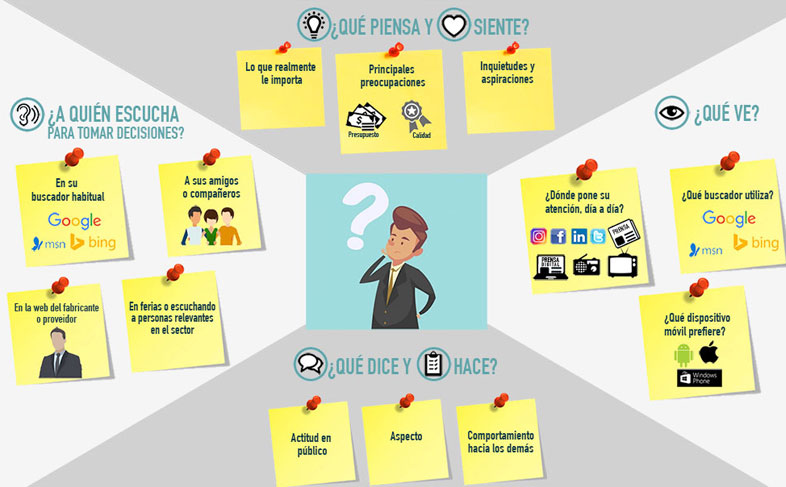All the digital projects that we carry out in DigitalMakers focus on a key element: people. Our goal is to meet your needs and solve your problems. It is important that before taking any step, let us know our audience to know what we have to say and how.
For this, we work with the digital empathy map, a marketing tool that allows us to understand our potential customers in depth.
Our working method is the DM0 (DigitalMakers Zero). In addition to the digital empathy map, we use other tools such as the business canvas and the horizons map. From here we can make the best digital proposal and achieve the business objectives of each client.
6 steps to follow to develop the digital empathy map in a work session
When we carry out a session to develop one or several digital empathy maps we need to gather a DigitalMakers consultant and part of our client’s team, ideally those who have a more complete knowledge of the final client (responsible for customer service, commercial, etc).
The consultant of DigitalMakers is the one who leads the session, dynamizes the assistants and advises and advises on how to solve the doubts that are appearing. Each session is planned and follows an order of actions:
1. Size the session
The session of digital empathy maps always lasts an hour and a half. Marking a specific duration allows us not to digress and focus on what is important. When we finish, we get a first draft of one or several empathy maps in hypothesis format, to be able to start working. Obviously, we will have to update this document as we move forward in the project.
2. Explain why
As we have already said, “the person” is for us the center of every digital project. That is why it is key that, before we start, all the members of the team know what is the map of actors of the digital ecosystem that we have in hand.
At DigitalMakers, working on the map of actors and the digital empathy map of each client is always the first step in any digital transformation project we carry out.
Keeping in mind at all times who our client is will constantly determine the decisions we make.
For example, if we have a 50-year-old English client living in London, and we want to interact with it through a web platform, it should have a co.uk domain and it should be written in English. Also, since the person is 50 years old and is likely to have eyestrain, it would be advisable that the letters and colors be easy to read.
We integrate this step into our DM0 method.
3. Describe the map of actors of the digital ecosystem
To begin this process, we first have to map the actors of the digital ecosystem. For example, suppose we are making the map of actors in an online store.
It would probably be something similar to:

Keep in mind that each map of actors is different, depending on each case.
The most important thing is that the map shows all the actors that interact in some way in the ecosystem. Later we will see that some will develop more than others.
It is also important that we do not forget that the map of actors and the empathy map can vary.
At the beginning we generated a HYPOTHESIS with:
- Who do we think is our client?
- How is our client?
- Etc.
During the following months, based on the DATA we are obtaining (Google Analytics, direct contact with the client, Prestashop, etc.), we progressively update both the map of actors and the map of empathy.
Once we have the map of actors drawn, we will choose the actors on which we want to develop the digital empathy map.
You do not have to do them all at once. To start the exercise and see how it affects the decisions we are making, just 3, 2 or even just one.
4. Show a final example result of digital empathy map
We show an example of a digital empathy map type to the people who are present in the session, to visualize where we want to go.
5. Develop the digital empathy map
We will choose which actors we should work on (as we have said, between one and 3 to start is more than enough) and we will develop your basic data:
We can not remain in generalist data, we will go deeper to obtain more information:
- Name and surname.
- Birthdate.
- Where do you live.
- Where he works.
- Photo (to find the photo we recommend doing a fun exercise: Google search a person that corresponds to the image we have of the client, for example, someone who is well dressed or informal, who is young or older … A good start can be to write in the search engine of Google the name and the surnames that we have invented).
- How many languages do you understand well?
- Which language do you mainly use?
- What language do you use to search Google?
When we already have these basic data, we will investigate the person.

A digital empathy map can be very extensive. That is why we advise you to start with the most relevant and little by little we will already fill in the complementary data.
To establish what is most relevant, we must apply criteria. For example, we have to ask ourselves the following questions:
- Assuming it is an e-commerce, is this client also the user? Or maybe the person who buys is the department head but who interacts with the platform is someone with an administrative profile?
- Regardless of our interests, where does this person pay attention in their day to day? Watch instagram, look at facebook, linkedin, twitter, read the digital avant-garde or maybe physics, listen to the radio…
- What search engine do you use (Google, Bing, etc)?
- Which mobile device do you prefer (Android, Apple, etc.)?
- What worries you and how would you like to solve it? Here we have to be a little creative, put ourselves on their skin and not be restricted by our own limitations.
- If we talk about someone who has come to a corporate website to assess whether or not to buy a service: what annual budget do you have? Can this budget be consumed by unilateral decision or do you need authorization from someone?
- In your day to day, what are your main functions at work?
- When you hire a project from a provider, what is your main fear? For example, that does not meet the delivery dates, or that the incidents that do not know how to handle, or that does not adequately inform the client…
- When you hire a project from a supplier, what exactly are you looking for? For example, technical capacity of the team, commitment…
- When you have to hire a new service, who do you listen to to make decisions? Search in Google, search the web of your suppliers, search the manufacturer’s website, go to fairs, talk with colleagues…
6. Include the result in the DM0 strategic consulting document
Finally, we collect all the results in a strategic consulting document that we call DM0. These results will serve as a starting point for any action included in the digital marketing plan.
This is how we work in DigitalMakers. From the person and towards the person. Never lose sight of your interests and behaviors.
We like to do the job well. That is why we start our digital projects with a good session of creation of digital empathy maps.
If this article has seemed interesting to you, subscribe to our community and follow us on our social networks to be informed of everything that is relevant in digital marketing.
We want to share with you our experience to grow knowledge.











